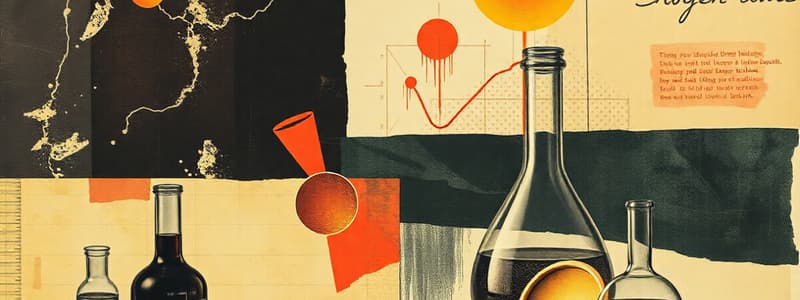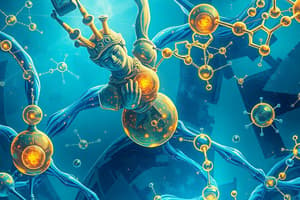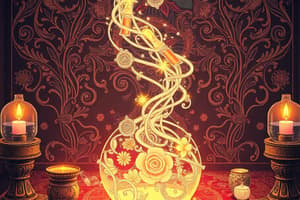Podcast
Questions and Answers
Which statement best describes reactions that release energy?
Which statement best describes reactions that release energy?
- They can start without any initial energy input.
- They necessarily absorb energy from their surroundings.
- They always require continuous input of energy to proceed.
- They might require some initial energy to start, but then release energy. (correct)
According to the information provided, energy can be created during a chemical reaction.
According to the information provided, energy can be created during a chemical reaction.
False (B)
What is a key question regarding energy changes in chemical reactions based on the content?
What is a key question regarding energy changes in chemical reactions based on the content?
Why do some reactions give off thermal energy and some absorb thermal energy?
Reactions that release energy may require some initial energy to get ______.
Reactions that release energy may require some initial energy to get ______.
Match the statements with the phase they describe for change of mind after the lesson:
Match the statements with the phase they describe for change of mind after the lesson:
Based on the text, what is the primary focus of the lesson?
Based on the text, what is the primary focus of the lesson?
Reactions that absorb thermal energy give off energy as heat.
Reactions that absorb thermal energy give off energy as heat.
What type of energy is highlighted as being released or absorbed in a chemical reaction according to the text?
What type of energy is highlighted as being released or absorbed in a chemical reaction according to the text?
What effect does increasing the concentration of reactants have on a chemical reaction?
What effect does increasing the concentration of reactants have on a chemical reaction?
The law of conservation of energy states that energy can be created and destroyed.
The law of conservation of energy states that energy can be created and destroyed.
What happens to energy when chemical bonds form?
What happens to energy when chemical bonds form?
In a hot pack, energy moves to the environment as it is released by the chemical _________ of the reactants.
In a hot pack, energy moves to the environment as it is released by the chemical _________ of the reactants.
Match the following terms with their descriptions:
Match the following terms with their descriptions:
What happens to the energy when plants are eaten by animals?
What happens to the energy when plants are eaten by animals?
When plants and animals die, the energy and matter contained in their tissues are destroyed.
When plants and animals die, the energy and matter contained in their tissues are destroyed.
Besides thermal energy, what is another way energy can return to the environment when organisms die?
Besides thermal energy, what is another way energy can return to the environment when organisms die?
What happens when atoms collide with the correct amount of force?
What happens when atoms collide with the correct amount of force?
The formation of chemical bonds requires energy input.
The formation of chemical bonds requires energy input.
When atoms form bonds, what forms of energy do they release?
When atoms form bonds, what forms of energy do they release?
The energy released when atoms form bonds is called chemical ______ energy.
The energy released when atoms form bonds is called chemical ______ energy.
What does chemical potential energy depend on?
What does chemical potential energy depend on?
All chemical reactions only release energy.
All chemical reactions only release energy.
How can temperature changes in hot and cold packs be explained, considering that all reactions both absorb and release energy?
How can temperature changes in hot and cold packs be explained, considering that all reactions both absorb and release energy?
In an exothermic reaction, what is the relationship between energy released during product formation and energy required to break reactant bonds?
In an exothermic reaction, what is the relationship between energy released during product formation and energy required to break reactant bonds?
In an exothermic reaction, thermal energy is written on the reactants side of the chemical equation.
In an exothermic reaction, thermal energy is written on the reactants side of the chemical equation.
What does the prefix 'exo-' mean in the term 'exothermic'?
What does the prefix 'exo-' mean in the term 'exothermic'?
The bonds of the _________ contain more energy than the bonds of the products in an exothermic reaction.
The bonds of the _________ contain more energy than the bonds of the products in an exothermic reaction.
What is the role of chemical reactions in living organisms?
What is the role of chemical reactions in living organisms?
Plants use photosynthesis to release energy.
Plants use photosynthesis to release energy.
What two types of atoms are produced when plant cells split water during photosynthesis?
What two types of atoms are produced when plant cells split water during photosynthesis?
What causes a hot pack to become hot?
What causes a hot pack to become hot?
All chemical bonds release and absorb the same amount of energy.
All chemical bonds release and absorb the same amount of energy.
What forms of energy are released in a firework?
What forms of energy are released in a firework?
Chemical reactions where more energy is required to break the bonds of the reactants than is released when products form are called ______ reactions.
Chemical reactions where more energy is required to break the bonds of the reactants than is released when products form are called ______ reactions.
In an endothermic reaction, where does thermal energy appear in the chemical equation?
In an endothermic reaction, where does thermal energy appear in the chemical equation?
What causes a cold pack to become cold?
What causes a cold pack to become cold?
The type of elements and compounds involved in a chemical reaction does not affect the overall change in energy.
The type of elements and compounds involved in a chemical reaction does not affect the overall change in energy.
What causes the temperature change in a chemical reaction?
What causes the temperature change in a chemical reaction?
Energy changes in chemical reactions only come from the surrounding environment.
Energy changes in chemical reactions only come from the surrounding environment.
What is always moving?
What is always moving?
The more energy particles have, the more they move and with one another.
The more energy particles have, the more they move and with one another.
Match the following:
Match the following:
In hot and cold packs, how is a temperature change achieved?
In hot and cold packs, how is a temperature change achieved?
The temperature change of a system only depends on collisions between particles.
The temperature change of a system only depends on collisions between particles.
Where does the energy from a chemical reaction come from?
Where does the energy from a chemical reaction come from?
Flashcards
Chemical Reaction
Chemical Reaction
A process involving the rearrangement of atoms and molecules, resulting in the formation of new substances with different properties.
Exothermic Reaction
Exothermic Reaction
Energy released during a chemical reaction, often in the form of heat or light.
Endothermic Reaction
Endothermic Reaction
Energy absorbed during a chemical reaction, often requiring an input of heat.
Activation Energy
Activation Energy
Signup and view all the flashcards
Enthalpy Change
Enthalpy Change
Signup and view all the flashcards
Exothermic Reaction
Exothermic Reaction
Signup and view all the flashcards
Endothermic Reaction
Endothermic Reaction
Signup and view all the flashcards
Specific Heat Capacity
Specific Heat Capacity
Signup and view all the flashcards
Bond Energy
Bond Energy
Signup and view all the flashcards
Chemical Equation
Chemical Equation
Signup and view all the flashcards
Heat Transfer in a Hot Pack
Heat Transfer in a Hot Pack
Signup and view all the flashcards
Energy Transfer
Energy Transfer
Signup and view all the flashcards
Chemical Bond Energy
Chemical Bond Energy
Signup and view all the flashcards
Internal Energy
Internal Energy
Signup and view all the flashcards
Heat Transfer
Heat Transfer
Signup and view all the flashcards
Thermochemistry
Thermochemistry
Signup and view all the flashcards
Bond Breaking Requires Energy
Bond Breaking Requires Energy
Signup and view all the flashcards
Bond Formation Releases Energy
Bond Formation Releases Energy
Signup and view all the flashcards
Chemical Potential Energy
Chemical Potential Energy
Signup and view all the flashcards
Chemical Potential Energy and Bond Strength
Chemical Potential Energy and Bond Strength
Signup and view all the flashcards
Energy Flow in Chemical Reactions
Energy Flow in Chemical Reactions
Signup and view all the flashcards
Energy Balance in Reactions
Energy Balance in Reactions
Signup and view all the flashcards
Photosynthesis
Photosynthesis
Signup and view all the flashcards
Exothermic Process
Exothermic Process
Signup and view all the flashcards
Endothermic Process
Endothermic Process
Signup and view all the flashcards
How Concentration Affects Reactions
How Concentration Affects Reactions
Signup and view all the flashcards
Law of Conservation of Energy
Law of Conservation of Energy
Signup and view all the flashcards
Energy in Chemical Reactions
Energy in Chemical Reactions
Signup and view all the flashcards
Energy Flow in Ecosystems
Energy Flow in Ecosystems
Signup and view all the flashcards
Hot Packs and Cold Packs
Hot Packs and Cold Packs
Signup and view all the flashcards
Overall Energy Remains Constant
Overall Energy Remains Constant
Signup and view all the flashcards
Study Notes
Matter: Properties and Changes - Energy Changes in Chemical Reactions
- Chemical reactions involve energy transfers—some release energy, others absorb it.
- Reactions that release energy don't need energy to start. Energy is released during the reaction.
- Energy is not created or destroyed in a chemical reaction, it's transferred between chemical bonds and the surroundings.
- Energy in chemical reactions comes from the chemical bonds holding the reacting atoms together or from the surroundings.
- Chemical bonds breaking requires energy, while forming bonds releases energy.
- The arrangement and strength of the bonds in a substance determine its chemical potential energy.
- Hot packs release energy, causing a temperature increase. This is an exothermic reaction.
- Cold packs absorb energy, causing a temperature decrease. This is an endothermic reaction.
- Energy transfers constantly occur between atoms and the environment.
- The amount of energy released or absorbed during a chemical reaction depends on the type of chemical bonds breaking and forming.
- The law of conservation of energy states energy can't be created or destroyed, only transferred.
- Organisms use chemical reactions to provide energy for their cells.
- Photosynthesis converts sunlight into chemical energy, and cellular respiration releases energy stored in the bonds of molecules like glucose.
- The concentration of reactants affects the speed of the reaction. Higher concentrations lead to more frequent collisions, speeding up the reaction, and influencing products.
Studying That Suits You
Use AI to generate personalized quizzes and flashcards to suit your learning preferences.




